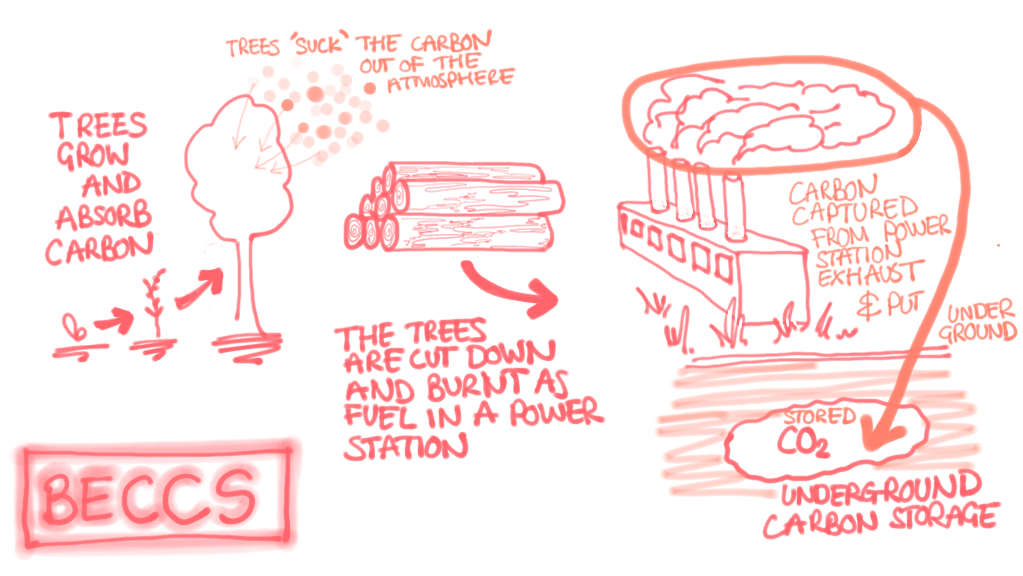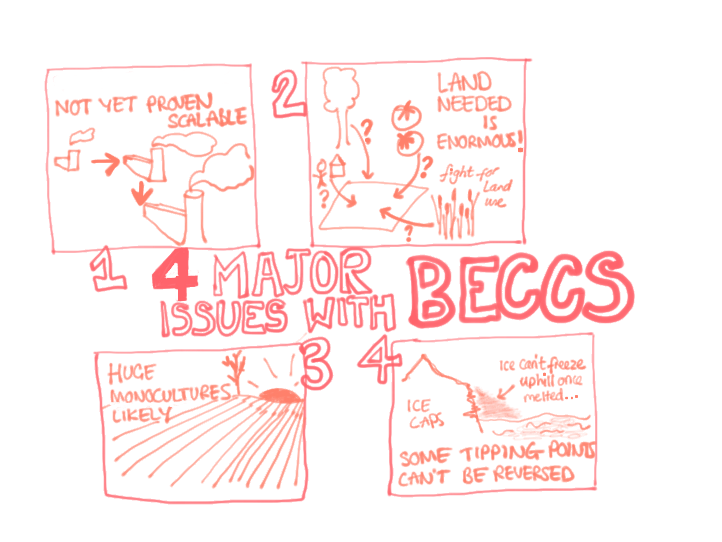What is BECCS?
BECCS stands for bio-energy carbon capture with storage. It’s one of the most widely adopted ideas for saving the planet what we are all (unknowingly) taking a huge gamble on! BECCS is a plan to take carbon out of the atmosphere and store it in the ground instead. Removing carbon from the atmosphere in the future means we can be less tight with what we emit today. The problem is extra allowance for BECCS in the future is already included in most climate forecast that we go off today. Is BECCS a gamble? It definitely is- we are all involved in a big gamble. If BECCS doesn’t work as well as it should, we’ve already overshot carbon emission level we were desperate to avoid.
You might say “sure- but it must work or why would it be included?”. This post will show the 4 biggest problems with scaling it up… should we be worried???
How does it work?
An Australian scientist came up with the concept in 2001. He suggested that large scale tree farms are grown to draw carbon out of the air. As trees grow, they absorb carbon. Once grown, the trees would be cut and mulched into wood pellets. These pellets would be burnt (in the same way fossil fuels are) and the carbon dioxide released from burning them would be captured and stored underground.
Overall, you’d get carbon absorbed while the tree grows, carbon released in a controlled space while the fuel in combusted to make electricity, and carbon then stored underground rather than let off into the atmosphere.

The BECCS hype and mass adoption
At the time it was such an exciting idea! The IPCC (the Intergovernmental Panel on Climate Change) started integrating BECCS into most of their climate models and projections of future scenarios. Most of the projections today contain extra carbon allowances assuming that part of emissions will be reversed by mass scale BECCs (that we currently haven’t developed the technology for).
Using BECCS in climate models isn’t necessarily bad, but it’s a huge gamble. The BECCS technology is not widely tested/scalable/efficient. If we are planning a scenario where carbon gets taken out of the atmosphere, that means the carbon we’re emitting today and will be emitting in the future is an overshoot even if we’re following the very ambitions carbon reduction targets. If we don’t develop scalable systems and the right technology fast enough, the gamble hasn’t paid off. We’ll have irreversibly overshot our allowances. So let’s look at exactly what we’ve gambled on.
What are the problems and risks with BECCS?
I’ve taken a summary of four of the biggest problems form this book “less is more”by Jason Hickel.
1) The technology is not proven scalable.
It might work out fine on a big scale but we just don’t know. What we do know is that the scale would be absolutely enormous and hugely expensive. This next bit is in an article from climate news in 2017: A single CCS facility can absorb about 1 million tonnes of carbon. This is not nearly enough- we would need 15,000 of these. Whatever the exact numbers, is will be a massive investment. The only way we could make it cost effective is it there were something like a huge government-imposed tax on carbon. It could happen but would need a lot of investment, and cooperation and funding- which is the gamble we are taking by including it in our climate projections.
2) The land that would be needed to scale BECCS is ENORMOUS (unachievably enormous)
A huge amount of farmable land would be needed to grow the trees for BECCS. In fact 2/3 of all the viable farming land on the whole planet would be needed to absorb the amount of carbon in some of the climate scenarios proposed (according to Jason Hickel in his book). Land is already a tight resource. With the Earths population rising, there are already questions about how the available land can be used to feed the 9 million people (!) that are expected to exist over the next few hundred years. If we’re struggling as it is, we can’t just give up and extra 2/3 for trees.
3) Issues of large monoculture farming and lack of land for alternatives
To clear up land for these huge tree plantations, whole ecosystems would likely be destroyed in creating the space. Given the world we live in, monoculture farming is the cheapest way to mass produce although it’s disastrous for the planet. Of course you could try and farm the trees more sustainable but whenever you pull something like that- it’s expensive and the whole idea of BECCS is not cheap to begin with.
4) There are some tipping points that can’t be reversed
The effects of carbon dioxide into the atmosphere are not linear. What this means is that the ecosystems is full of forwards and backwards and crossing over causes and effects. There are many self re-enforcing loops that once started can not go into reverse.
For example, the ice sheets in the arctic; as the outer most layers melt away the area exposed is much greater, this means a larger surface area is directly hit by sunlight in the summer. The rate of melting increases forever as the front sheets expose more and more of the block behind them. Reducing the amount of carbon in the atmosphere won’t reduce the surface area of the exposed blocks. Another example, as Ice melts, large amounts of carbon dioxide stored in the ice will be released into the atmosphere.
We might be able to compensation for some of the emissions we have created with BECCS but the massive additional loads of carbon that have been released won’t even be absorbed back into the ice. Some disasters won’t be reversed by BECCS. (See my post on climate change for more on this).

What does all of this mean?
It means we are locked into a climate gamble. It also makes us ask, do we need to leave a bit more breathing room while we see how BECCS is developing? At the very least, it’s only fair to know these things.
Can’t we just capture the carbon released from burning fossil fuels?
This is weirdly a question that I realised while writing this post that I don’t fully know the answer to! So I had a little google. Carbon capture and storage is called CCS. The main problem is, it’s electrically intensive. This means you’re still using fossil fuels sourced electricity to capture the carbon.
What if you used renewable energy to do that?
Yes, that might work, but then it’s more effective to just use the renewable energy directly to replace fossil fuels. We don’t have enough renewable energy to make all the electricity we use ‘green’ at the moment. We will need a whole heap more to make transportation and heating carbon neutral. This is already a huge demand that we will have to be striving for in the future. So, It seems a bit illogical given how much more research and investment CCS technology needs to be cost effective and efficient in the future.
Conclusion
This post “is BECCS a gamble?” is over- but I’m not sure either what the conclusion to this topic is. Sometimes climate dread is stressful- sometimes it leaves me feeling serious but inspired! What CAN we do?! What will/are engineers coming up with as we speak…so maybe the next few posts will be able that to balance things out.
Thanks for reading! new posts every Tuesday at 11am. Comment below or send me a message to say hi if you’re reading this.

